Class, Wealth, and Poverty in English Literature
VerifiedAdded on 2023/01/19
|13
|3478
|63
AI Summary
This article discusses the portrayal of class, wealth, and poverty in English literature, specifically focusing on the novels North and South by Elizabeth Gaskell and Great Expectations by Charles Dickens. It examines how these novels reflect the socio-economic conditions of the society during the nineteenth century in Great Britain.
Contribute Materials
Your contribution can guide someone’s learning journey. Share your
documents today.
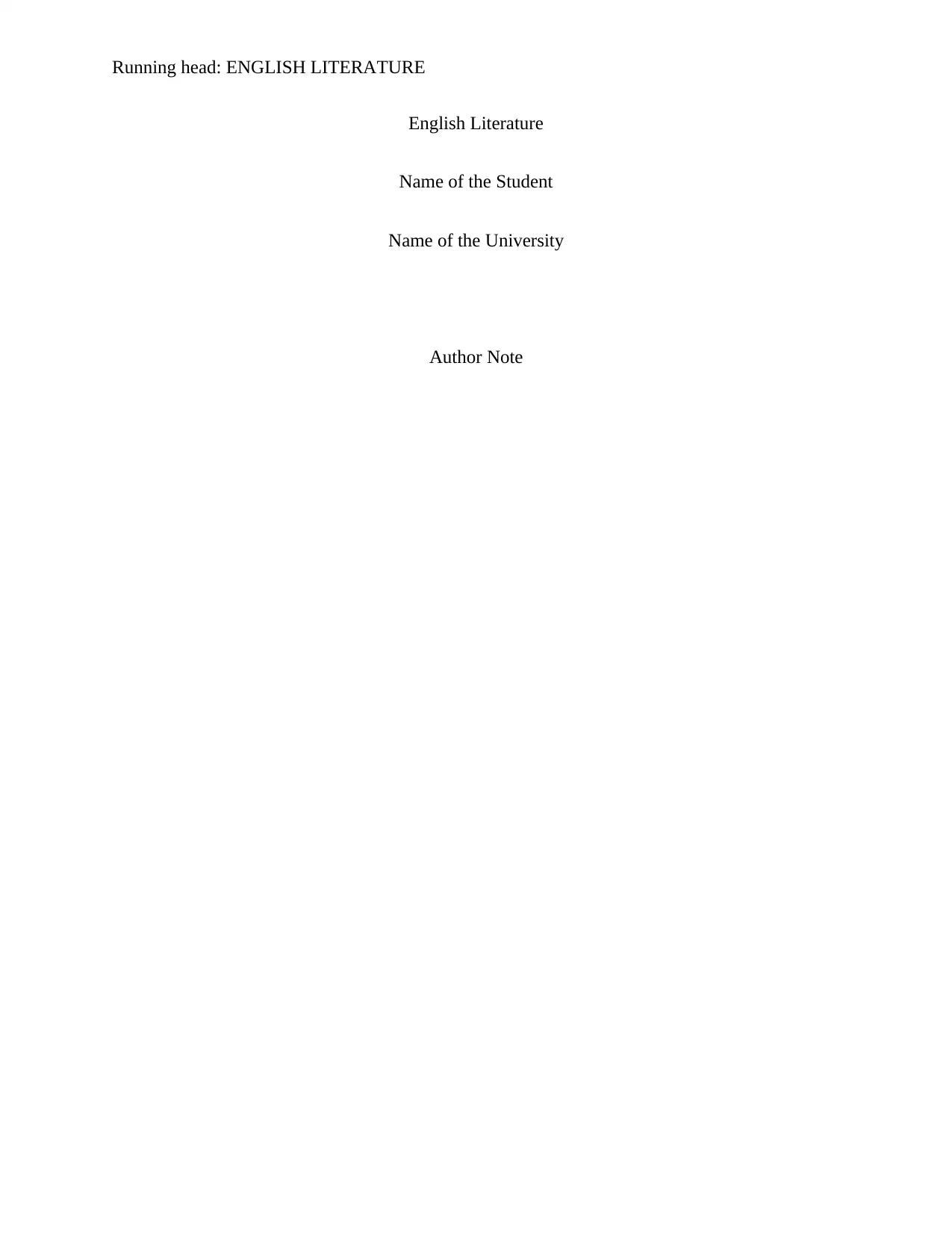
Running head: ENGLISH LITERATURE
English Literature
Name of the Student
Name of the University
Author Note
English Literature
Name of the Student
Name of the University
Author Note
Secure Best Marks with AI Grader
Need help grading? Try our AI Grader for instant feedback on your assignments.
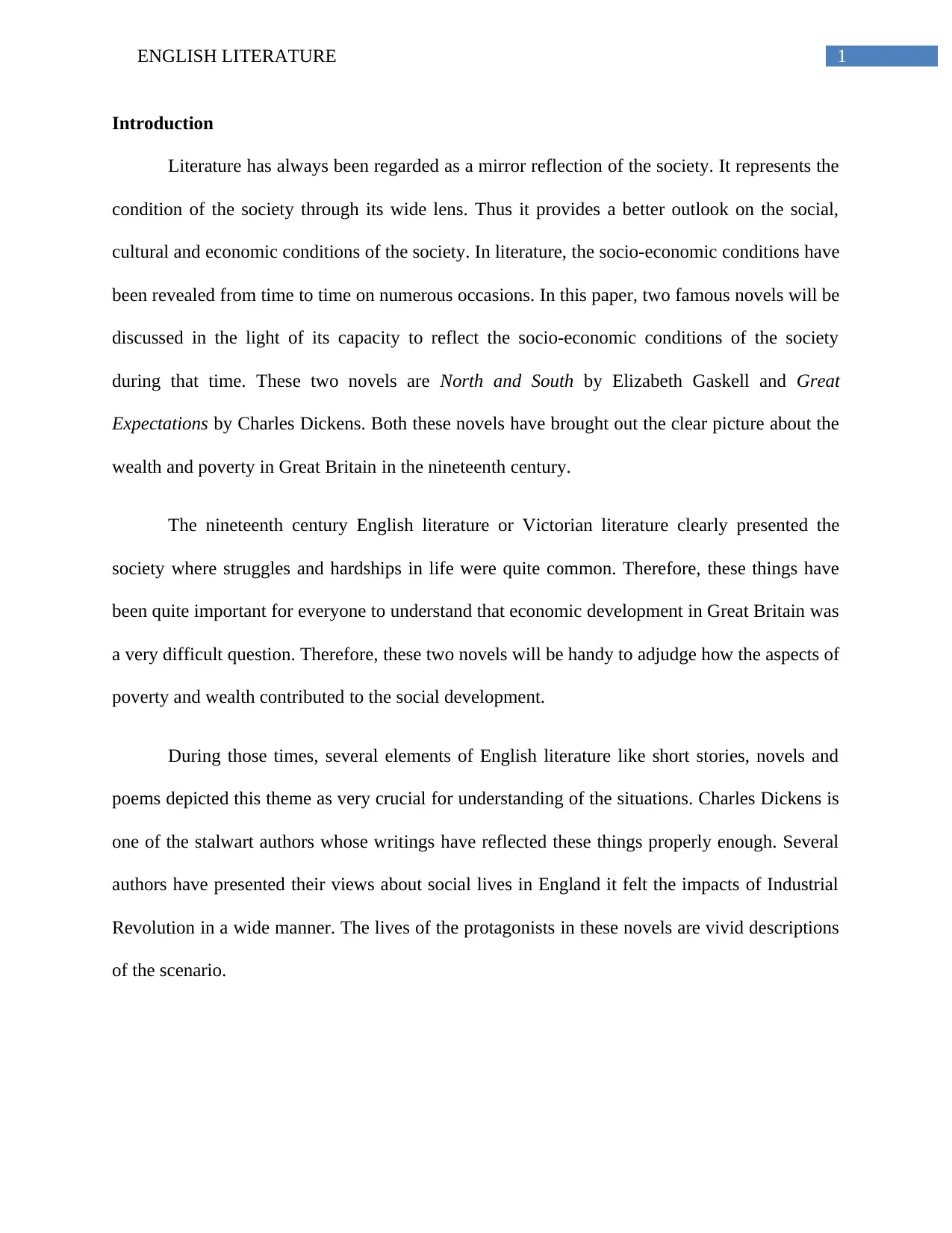
1ENGLISH LITERATURE
Introduction
Literature has always been regarded as a mirror reflection of the society. It represents the
condition of the society through its wide lens. Thus it provides a better outlook on the social,
cultural and economic conditions of the society. In literature, the socio-economic conditions have
been revealed from time to time on numerous occasions. In this paper, two famous novels will be
discussed in the light of its capacity to reflect the socio-economic conditions of the society
during that time. These two novels are North and South by Elizabeth Gaskell and Great
Expectations by Charles Dickens. Both these novels have brought out the clear picture about the
wealth and poverty in Great Britain in the nineteenth century.
The nineteenth century English literature or Victorian literature clearly presented the
society where struggles and hardships in life were quite common. Therefore, these things have
been quite important for everyone to understand that economic development in Great Britain was
a very difficult question. Therefore, these two novels will be handy to adjudge how the aspects of
poverty and wealth contributed to the social development.
During those times, several elements of English literature like short stories, novels and
poems depicted this theme as very crucial for understanding of the situations. Charles Dickens is
one of the stalwart authors whose writings have reflected these things properly enough. Several
authors have presented their views about social lives in England it felt the impacts of Industrial
Revolution in a wide manner. The lives of the protagonists in these novels are vivid descriptions
of the scenario.
Introduction
Literature has always been regarded as a mirror reflection of the society. It represents the
condition of the society through its wide lens. Thus it provides a better outlook on the social,
cultural and economic conditions of the society. In literature, the socio-economic conditions have
been revealed from time to time on numerous occasions. In this paper, two famous novels will be
discussed in the light of its capacity to reflect the socio-economic conditions of the society
during that time. These two novels are North and South by Elizabeth Gaskell and Great
Expectations by Charles Dickens. Both these novels have brought out the clear picture about the
wealth and poverty in Great Britain in the nineteenth century.
The nineteenth century English literature or Victorian literature clearly presented the
society where struggles and hardships in life were quite common. Therefore, these things have
been quite important for everyone to understand that economic development in Great Britain was
a very difficult question. Therefore, these two novels will be handy to adjudge how the aspects of
poverty and wealth contributed to the social development.
During those times, several elements of English literature like short stories, novels and
poems depicted this theme as very crucial for understanding of the situations. Charles Dickens is
one of the stalwart authors whose writings have reflected these things properly enough. Several
authors have presented their views about social lives in England it felt the impacts of Industrial
Revolution in a wide manner. The lives of the protagonists in these novels are vivid descriptions
of the scenario.
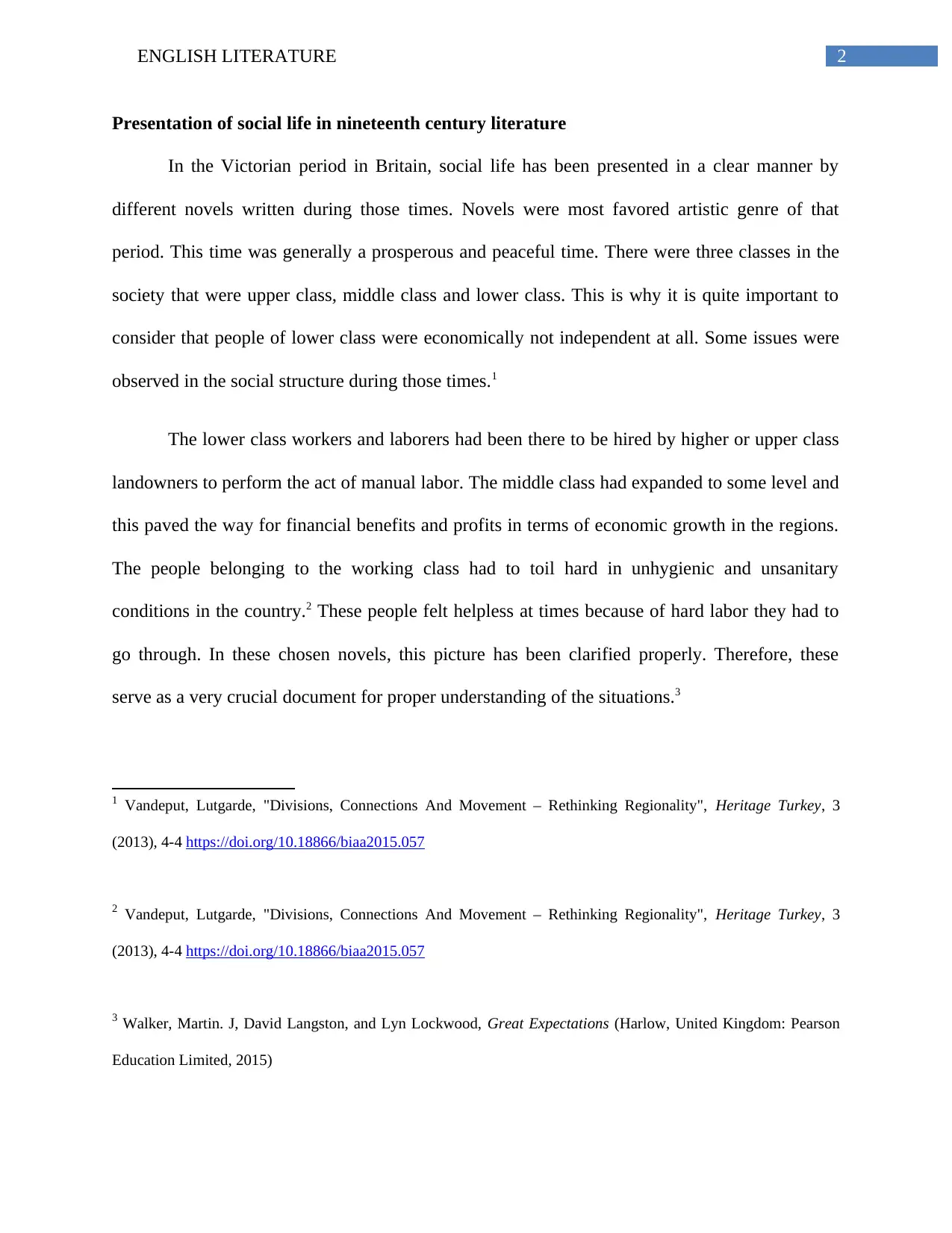
2ENGLISH LITERATURE
Presentation of social life in nineteenth century literature
In the Victorian period in Britain, social life has been presented in a clear manner by
different novels written during those times. Novels were most favored artistic genre of that
period. This time was generally a prosperous and peaceful time. There were three classes in the
society that were upper class, middle class and lower class. This is why it is quite important to
consider that people of lower class were economically not independent at all. Some issues were
observed in the social structure during those times.1
The lower class workers and laborers had been there to be hired by higher or upper class
landowners to perform the act of manual labor. The middle class had expanded to some level and
this paved the way for financial benefits and profits in terms of economic growth in the regions.
The people belonging to the working class had to toil hard in unhygienic and unsanitary
conditions in the country.2 These people felt helpless at times because of hard labor they had to
go through. In these chosen novels, this picture has been clarified properly. Therefore, these
serve as a very crucial document for proper understanding of the situations.3
1 Vandeput, Lutgarde, "Divisions, Connections And Movement – Rethinking Regionality", Heritage Turkey, 3
(2013), 4-4 https://doi.org/10.18866/biaa2015.057
2 Vandeput, Lutgarde, "Divisions, Connections And Movement – Rethinking Regionality", Heritage Turkey, 3
(2013), 4-4 https://doi.org/10.18866/biaa2015.057
3 Walker, Martin. J, David Langston, and Lyn Lockwood, Great Expectations (Harlow, United Kingdom: Pearson
Education Limited, 2015)
Presentation of social life in nineteenth century literature
In the Victorian period in Britain, social life has been presented in a clear manner by
different novels written during those times. Novels were most favored artistic genre of that
period. This time was generally a prosperous and peaceful time. There were three classes in the
society that were upper class, middle class and lower class. This is why it is quite important to
consider that people of lower class were economically not independent at all. Some issues were
observed in the social structure during those times.1
The lower class workers and laborers had been there to be hired by higher or upper class
landowners to perform the act of manual labor. The middle class had expanded to some level and
this paved the way for financial benefits and profits in terms of economic growth in the regions.
The people belonging to the working class had to toil hard in unhygienic and unsanitary
conditions in the country.2 These people felt helpless at times because of hard labor they had to
go through. In these chosen novels, this picture has been clarified properly. Therefore, these
serve as a very crucial document for proper understanding of the situations.3
1 Vandeput, Lutgarde, "Divisions, Connections And Movement – Rethinking Regionality", Heritage Turkey, 3
(2013), 4-4 https://doi.org/10.18866/biaa2015.057
2 Vandeput, Lutgarde, "Divisions, Connections And Movement – Rethinking Regionality", Heritage Turkey, 3
(2013), 4-4 https://doi.org/10.18866/biaa2015.057
3 Walker, Martin. J, David Langston, and Lyn Lockwood, Great Expectations (Harlow, United Kingdom: Pearson
Education Limited, 2015)
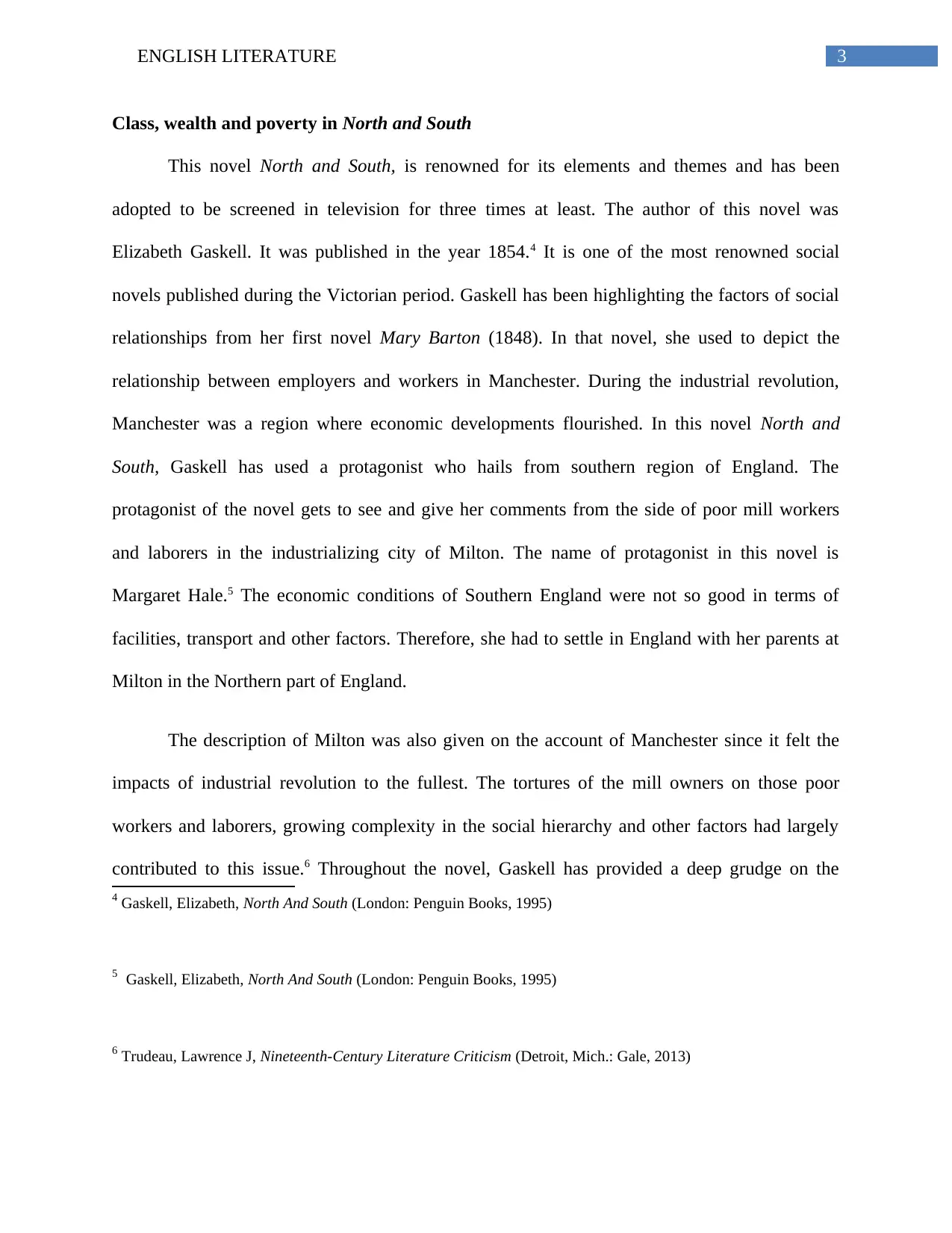
3ENGLISH LITERATURE
Class, wealth and poverty in North and South
This novel North and South, is renowned for its elements and themes and has been
adopted to be screened in television for three times at least. The author of this novel was
Elizabeth Gaskell. It was published in the year 1854.4 It is one of the most renowned social
novels published during the Victorian period. Gaskell has been highlighting the factors of social
relationships from her first novel Mary Barton (1848). In that novel, she used to depict the
relationship between employers and workers in Manchester. During the industrial revolution,
Manchester was a region where economic developments flourished. In this novel North and
South, Gaskell has used a protagonist who hails from southern region of England. The
protagonist of the novel gets to see and give her comments from the side of poor mill workers
and laborers in the industrializing city of Milton. The name of protagonist in this novel is
Margaret Hale.5 The economic conditions of Southern England were not so good in terms of
facilities, transport and other factors. Therefore, she had to settle in England with her parents at
Milton in the Northern part of England.
The description of Milton was also given on the account of Manchester since it felt the
impacts of industrial revolution to the fullest. The tortures of the mill owners on those poor
workers and laborers, growing complexity in the social hierarchy and other factors had largely
contributed to this issue.6 Throughout the novel, Gaskell has provided a deep grudge on the
4 Gaskell, Elizabeth, North And South (London: Penguin Books, 1995)
5 Gaskell, Elizabeth, North And South (London: Penguin Books, 1995)
6 Trudeau, Lawrence J, Nineteenth-Century Literature Criticism (Detroit, Mich.: Gale, 2013)
Class, wealth and poverty in North and South
This novel North and South, is renowned for its elements and themes and has been
adopted to be screened in television for three times at least. The author of this novel was
Elizabeth Gaskell. It was published in the year 1854.4 It is one of the most renowned social
novels published during the Victorian period. Gaskell has been highlighting the factors of social
relationships from her first novel Mary Barton (1848). In that novel, she used to depict the
relationship between employers and workers in Manchester. During the industrial revolution,
Manchester was a region where economic developments flourished. In this novel North and
South, Gaskell has used a protagonist who hails from southern region of England. The
protagonist of the novel gets to see and give her comments from the side of poor mill workers
and laborers in the industrializing city of Milton. The name of protagonist in this novel is
Margaret Hale.5 The economic conditions of Southern England were not so good in terms of
facilities, transport and other factors. Therefore, she had to settle in England with her parents at
Milton in the Northern part of England.
The description of Milton was also given on the account of Manchester since it felt the
impacts of industrial revolution to the fullest. The tortures of the mill owners on those poor
workers and laborers, growing complexity in the social hierarchy and other factors had largely
contributed to this issue.6 Throughout the novel, Gaskell has provided a deep grudge on the
4 Gaskell, Elizabeth, North And South (London: Penguin Books, 1995)
5 Gaskell, Elizabeth, North And South (London: Penguin Books, 1995)
6 Trudeau, Lawrence J, Nineteenth-Century Literature Criticism (Detroit, Mich.: Gale, 2013)
Secure Best Marks with AI Grader
Need help grading? Try our AI Grader for instant feedback on your assignments.
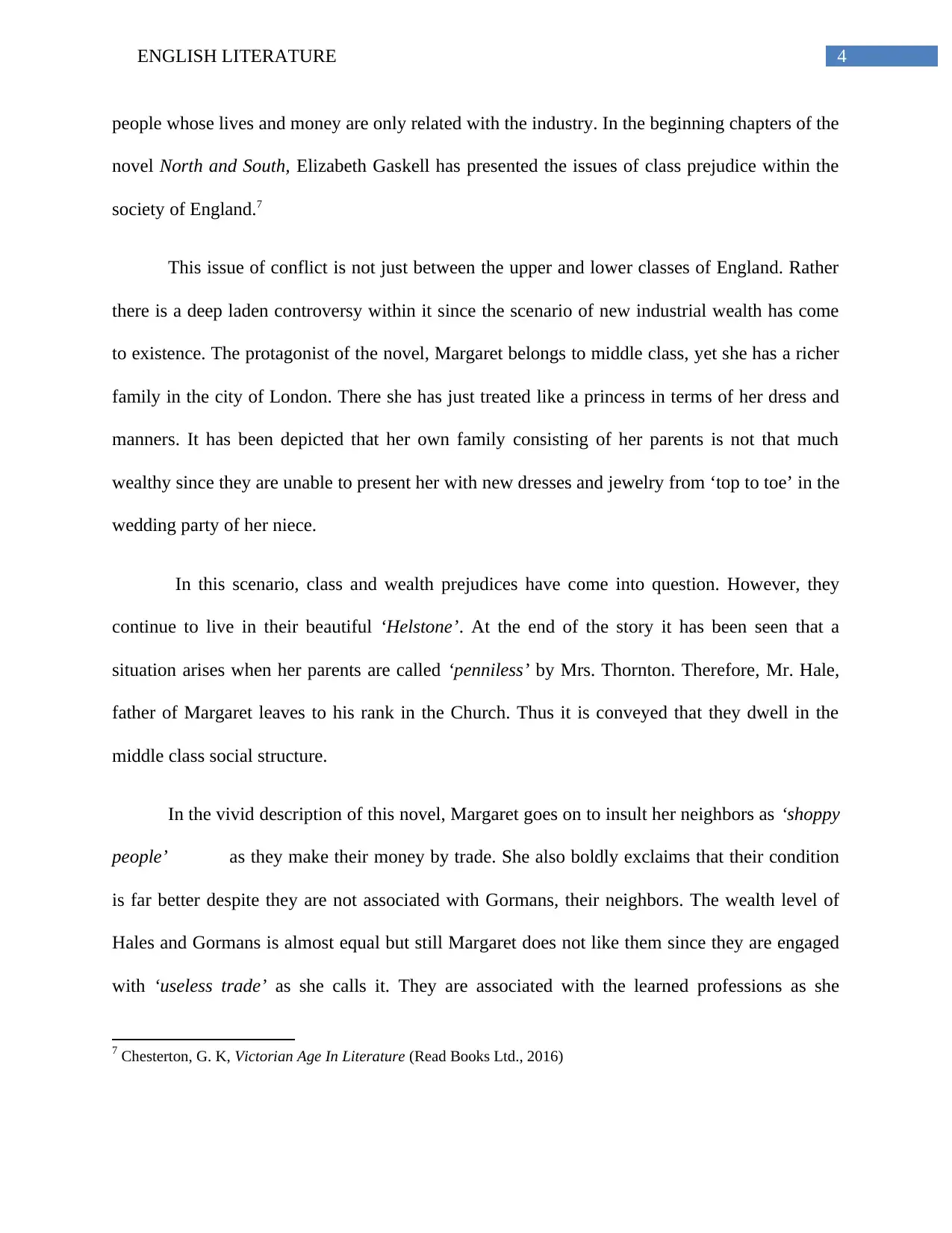
4ENGLISH LITERATURE
people whose lives and money are only related with the industry. In the beginning chapters of the
novel North and South, Elizabeth Gaskell has presented the issues of class prejudice within the
society of England.7
This issue of conflict is not just between the upper and lower classes of England. Rather
there is a deep laden controversy within it since the scenario of new industrial wealth has come
to existence. The protagonist of the novel, Margaret belongs to middle class, yet she has a richer
family in the city of London. There she has just treated like a princess in terms of her dress and
manners. It has been depicted that her own family consisting of her parents is not that much
wealthy since they are unable to present her with new dresses and jewelry from ‘top to toe’ in the
wedding party of her niece.
In this scenario, class and wealth prejudices have come into question. However, they
continue to live in their beautiful ‘Helstone’. At the end of the story it has been seen that a
situation arises when her parents are called ‘penniless’ by Mrs. Thornton. Therefore, Mr. Hale,
father of Margaret leaves to his rank in the Church. Thus it is conveyed that they dwell in the
middle class social structure.
In the vivid description of this novel, Margaret goes on to insult her neighbors as ‘shoppy
people’ as they make their money by trade. She also boldly exclaims that their condition
is far better despite they are not associated with Gormans, their neighbors. The wealth level of
Hales and Gormans is almost equal but still Margaret does not like them since they are engaged
with ‘useless trade’ as she calls it. They are associated with the learned professions as she
7 Chesterton, G. K, Victorian Age In Literature (Read Books Ltd., 2016)
people whose lives and money are only related with the industry. In the beginning chapters of the
novel North and South, Elizabeth Gaskell has presented the issues of class prejudice within the
society of England.7
This issue of conflict is not just between the upper and lower classes of England. Rather
there is a deep laden controversy within it since the scenario of new industrial wealth has come
to existence. The protagonist of the novel, Margaret belongs to middle class, yet she has a richer
family in the city of London. There she has just treated like a princess in terms of her dress and
manners. It has been depicted that her own family consisting of her parents is not that much
wealthy since they are unable to present her with new dresses and jewelry from ‘top to toe’ in the
wedding party of her niece.
In this scenario, class and wealth prejudices have come into question. However, they
continue to live in their beautiful ‘Helstone’. At the end of the story it has been seen that a
situation arises when her parents are called ‘penniless’ by Mrs. Thornton. Therefore, Mr. Hale,
father of Margaret leaves to his rank in the Church. Thus it is conveyed that they dwell in the
middle class social structure.
In the vivid description of this novel, Margaret goes on to insult her neighbors as ‘shoppy
people’ as they make their money by trade. She also boldly exclaims that their condition
is far better despite they are not associated with Gormans, their neighbors. The wealth level of
Hales and Gormans is almost equal but still Margaret does not like them since they are engaged
with ‘useless trade’ as she calls it. They are associated with the learned professions as she
7 Chesterton, G. K, Victorian Age In Literature (Read Books Ltd., 2016)
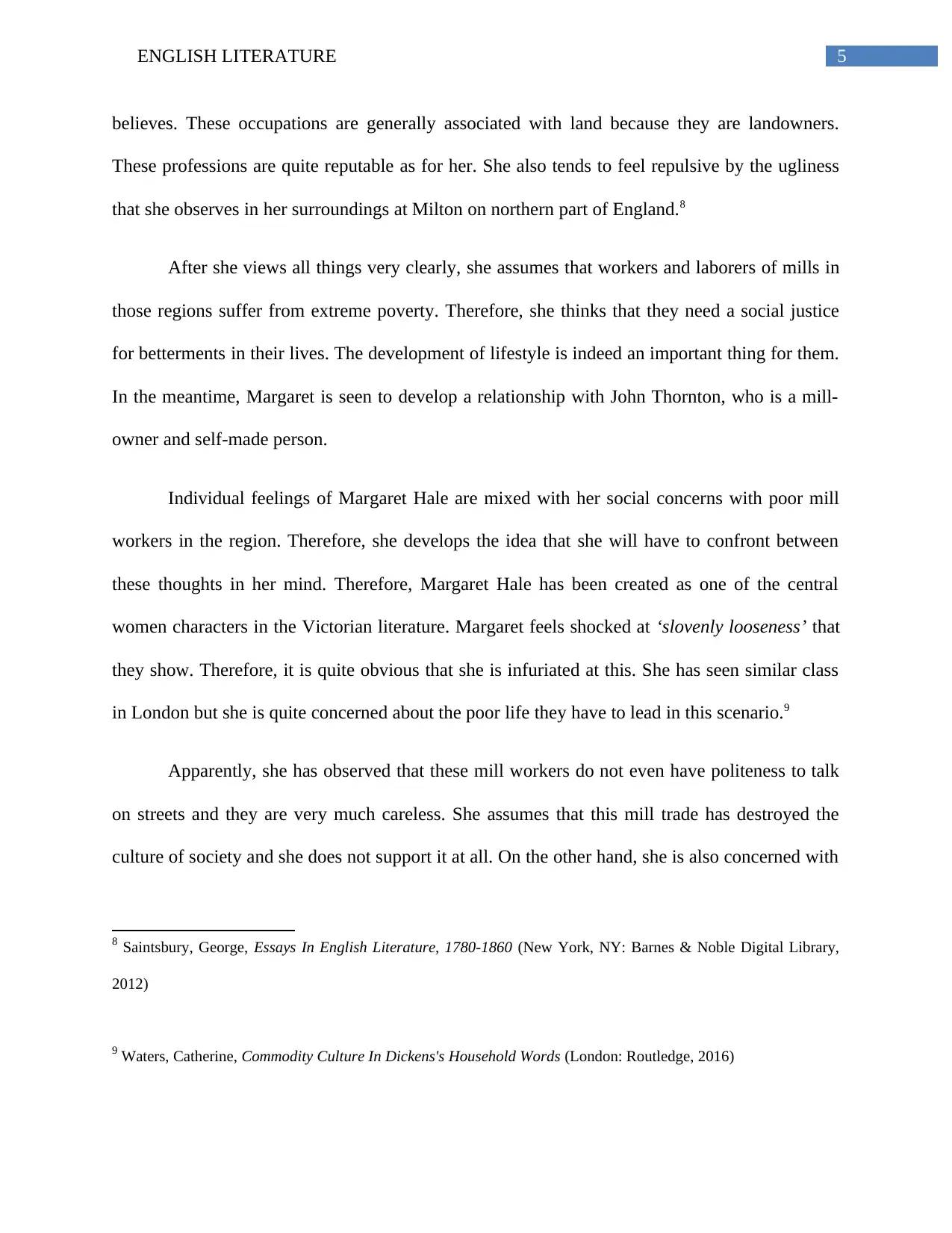
5ENGLISH LITERATURE
believes. These occupations are generally associated with land because they are landowners.
These professions are quite reputable as for her. She also tends to feel repulsive by the ugliness
that she observes in her surroundings at Milton on northern part of England.8
After she views all things very clearly, she assumes that workers and laborers of mills in
those regions suffer from extreme poverty. Therefore, she thinks that they need a social justice
for betterments in their lives. The development of lifestyle is indeed an important thing for them.
In the meantime, Margaret is seen to develop a relationship with John Thornton, who is a mill-
owner and self-made person.
Individual feelings of Margaret Hale are mixed with her social concerns with poor mill
workers in the region. Therefore, she develops the idea that she will have to confront between
these thoughts in her mind. Therefore, Margaret Hale has been created as one of the central
women characters in the Victorian literature. Margaret feels shocked at ‘slovenly looseness’ that
they show. Therefore, it is quite obvious that she is infuriated at this. She has seen similar class
in London but she is quite concerned about the poor life they have to lead in this scenario.9
Apparently, she has observed that these mill workers do not even have politeness to talk
on streets and they are very much careless. She assumes that this mill trade has destroyed the
culture of society and she does not support it at all. On the other hand, she is also concerned with
8 Saintsbury, George, Essays In English Literature, 1780-1860 (New York, NY: Barnes & Noble Digital Library,
2012)
9 Waters, Catherine, Commodity Culture In Dickens's Household Words (London: Routledge, 2016)
believes. These occupations are generally associated with land because they are landowners.
These professions are quite reputable as for her. She also tends to feel repulsive by the ugliness
that she observes in her surroundings at Milton on northern part of England.8
After she views all things very clearly, she assumes that workers and laborers of mills in
those regions suffer from extreme poverty. Therefore, she thinks that they need a social justice
for betterments in their lives. The development of lifestyle is indeed an important thing for them.
In the meantime, Margaret is seen to develop a relationship with John Thornton, who is a mill-
owner and self-made person.
Individual feelings of Margaret Hale are mixed with her social concerns with poor mill
workers in the region. Therefore, she develops the idea that she will have to confront between
these thoughts in her mind. Therefore, Margaret Hale has been created as one of the central
women characters in the Victorian literature. Margaret feels shocked at ‘slovenly looseness’ that
they show. Therefore, it is quite obvious that she is infuriated at this. She has seen similar class
in London but she is quite concerned about the poor life they have to lead in this scenario.9
Apparently, she has observed that these mill workers do not even have politeness to talk
on streets and they are very much careless. She assumes that this mill trade has destroyed the
culture of society and she does not support it at all. On the other hand, she is also concerned with
8 Saintsbury, George, Essays In English Literature, 1780-1860 (New York, NY: Barnes & Noble Digital Library,
2012)
9 Waters, Catherine, Commodity Culture In Dickens's Household Words (London: Routledge, 2016)
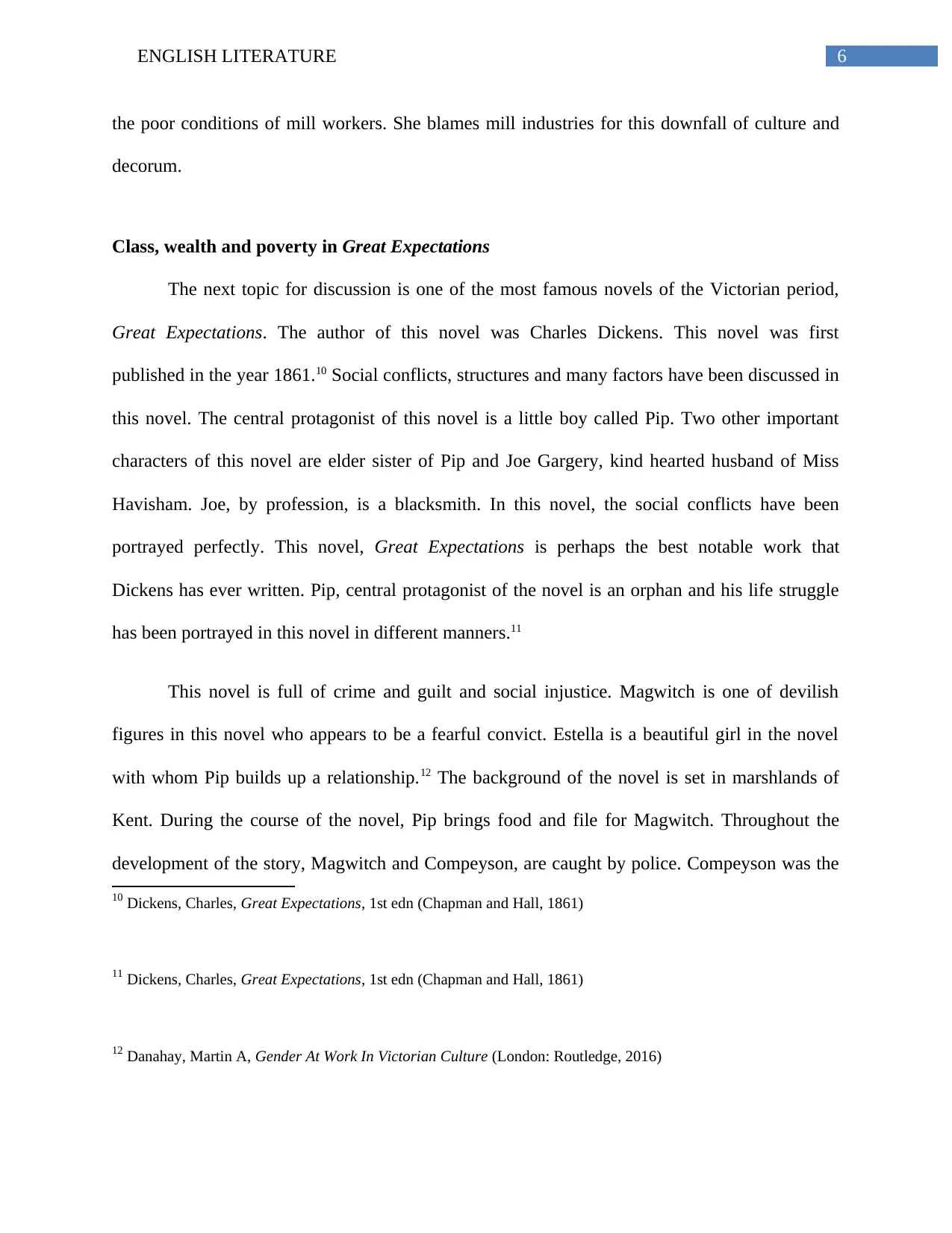
6ENGLISH LITERATURE
the poor conditions of mill workers. She blames mill industries for this downfall of culture and
decorum.
Class, wealth and poverty in Great Expectations
The next topic for discussion is one of the most famous novels of the Victorian period,
Great Expectations. The author of this novel was Charles Dickens. This novel was first
published in the year 1861.10 Social conflicts, structures and many factors have been discussed in
this novel. The central protagonist of this novel is a little boy called Pip. Two other important
characters of this novel are elder sister of Pip and Joe Gargery, kind hearted husband of Miss
Havisham. Joe, by profession, is a blacksmith. In this novel, the social conflicts have been
portrayed perfectly. This novel, Great Expectations is perhaps the best notable work that
Dickens has ever written. Pip, central protagonist of the novel is an orphan and his life struggle
has been portrayed in this novel in different manners.11
This novel is full of crime and guilt and social injustice. Magwitch is one of devilish
figures in this novel who appears to be a fearful convict. Estella is a beautiful girl in the novel
with whom Pip builds up a relationship.12 The background of the novel is set in marshlands of
Kent. During the course of the novel, Pip brings food and file for Magwitch. Throughout the
development of the story, Magwitch and Compeyson, are caught by police. Compeyson was the
10 Dickens, Charles, Great Expectations, 1st edn (Chapman and Hall, 1861)
11 Dickens, Charles, Great Expectations, 1st edn (Chapman and Hall, 1861)
12 Danahay, Martin A, Gender At Work In Victorian Culture (London: Routledge, 2016)
the poor conditions of mill workers. She blames mill industries for this downfall of culture and
decorum.
Class, wealth and poverty in Great Expectations
The next topic for discussion is one of the most famous novels of the Victorian period,
Great Expectations. The author of this novel was Charles Dickens. This novel was first
published in the year 1861.10 Social conflicts, structures and many factors have been discussed in
this novel. The central protagonist of this novel is a little boy called Pip. Two other important
characters of this novel are elder sister of Pip and Joe Gargery, kind hearted husband of Miss
Havisham. Joe, by profession, is a blacksmith. In this novel, the social conflicts have been
portrayed perfectly. This novel, Great Expectations is perhaps the best notable work that
Dickens has ever written. Pip, central protagonist of the novel is an orphan and his life struggle
has been portrayed in this novel in different manners.11
This novel is full of crime and guilt and social injustice. Magwitch is one of devilish
figures in this novel who appears to be a fearful convict. Estella is a beautiful girl in the novel
with whom Pip builds up a relationship.12 The background of the novel is set in marshlands of
Kent. During the course of the novel, Pip brings food and file for Magwitch. Throughout the
development of the story, Magwitch and Compeyson, are caught by police. Compeyson was the
10 Dickens, Charles, Great Expectations, 1st edn (Chapman and Hall, 1861)
11 Dickens, Charles, Great Expectations, 1st edn (Chapman and Hall, 1861)
12 Danahay, Martin A, Gender At Work In Victorian Culture (London: Routledge, 2016)
Paraphrase This Document
Need a fresh take? Get an instant paraphrase of this document with our AI Paraphraser
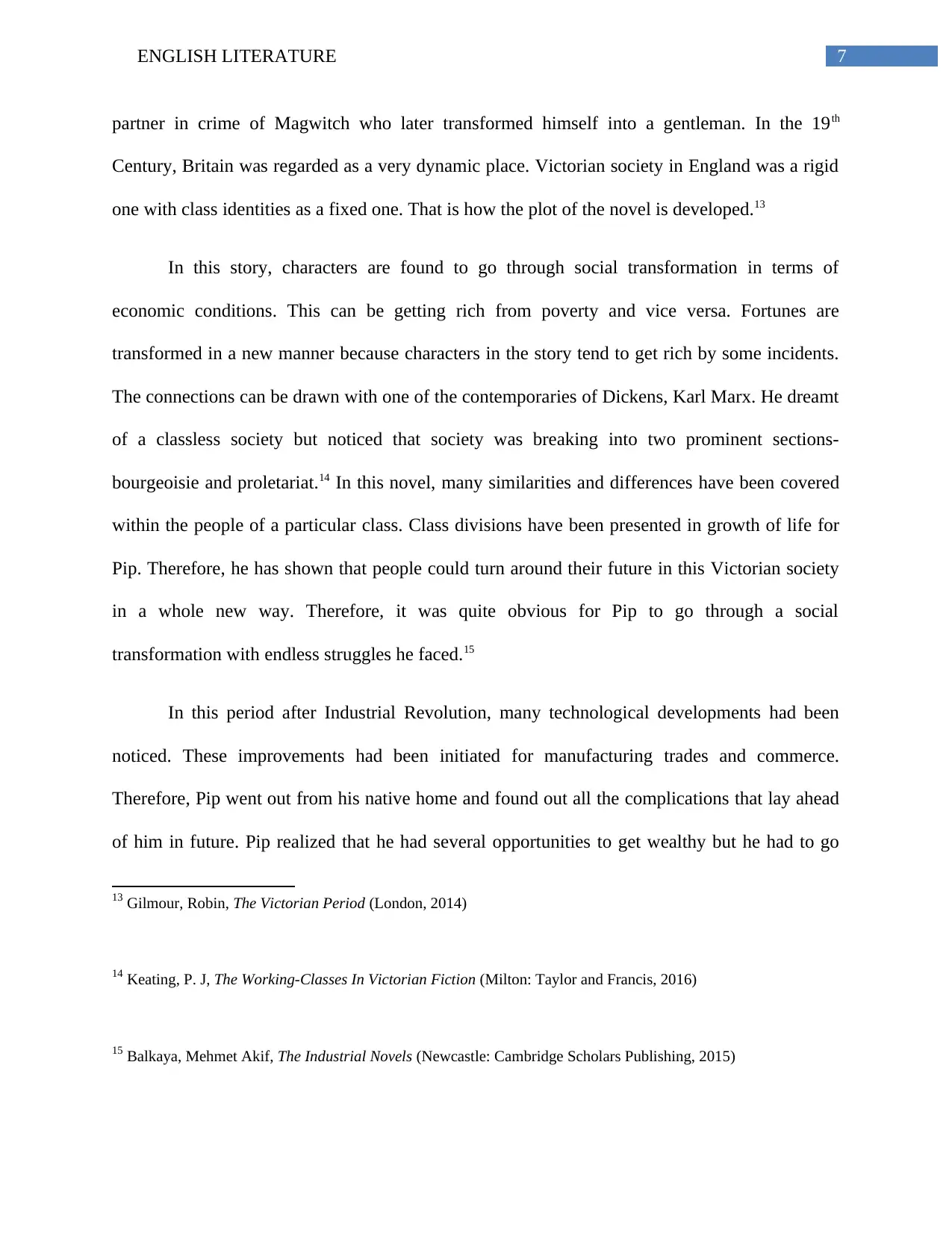
7ENGLISH LITERATURE
partner in crime of Magwitch who later transformed himself into a gentleman. In the 19th
Century, Britain was regarded as a very dynamic place. Victorian society in England was a rigid
one with class identities as a fixed one. That is how the plot of the novel is developed.13
In this story, characters are found to go through social transformation in terms of
economic conditions. This can be getting rich from poverty and vice versa. Fortunes are
transformed in a new manner because characters in the story tend to get rich by some incidents.
The connections can be drawn with one of the contemporaries of Dickens, Karl Marx. He dreamt
of a classless society but noticed that society was breaking into two prominent sections-
bourgeoisie and proletariat.14 In this novel, many similarities and differences have been covered
within the people of a particular class. Class divisions have been presented in growth of life for
Pip. Therefore, he has shown that people could turn around their future in this Victorian society
in a whole new way. Therefore, it was quite obvious for Pip to go through a social
transformation with endless struggles he faced.15
In this period after Industrial Revolution, many technological developments had been
noticed. These improvements had been initiated for manufacturing trades and commerce.
Therefore, Pip went out from his native home and found out all the complications that lay ahead
of him in future. Pip realized that he had several opportunities to get wealthy but he had to go
13 Gilmour, Robin, The Victorian Period (London, 2014)
14 Keating, P. J, The Working-Classes In Victorian Fiction (Milton: Taylor and Francis, 2016)
15 Balkaya, Mehmet Akif, The Industrial Novels (Newcastle: Cambridge Scholars Publishing, 2015)
partner in crime of Magwitch who later transformed himself into a gentleman. In the 19th
Century, Britain was regarded as a very dynamic place. Victorian society in England was a rigid
one with class identities as a fixed one. That is how the plot of the novel is developed.13
In this story, characters are found to go through social transformation in terms of
economic conditions. This can be getting rich from poverty and vice versa. Fortunes are
transformed in a new manner because characters in the story tend to get rich by some incidents.
The connections can be drawn with one of the contemporaries of Dickens, Karl Marx. He dreamt
of a classless society but noticed that society was breaking into two prominent sections-
bourgeoisie and proletariat.14 In this novel, many similarities and differences have been covered
within the people of a particular class. Class divisions have been presented in growth of life for
Pip. Therefore, he has shown that people could turn around their future in this Victorian society
in a whole new way. Therefore, it was quite obvious for Pip to go through a social
transformation with endless struggles he faced.15
In this period after Industrial Revolution, many technological developments had been
noticed. These improvements had been initiated for manufacturing trades and commerce.
Therefore, Pip went out from his native home and found out all the complications that lay ahead
of him in future. Pip realized that he had several opportunities to get wealthy but he had to go
13 Gilmour, Robin, The Victorian Period (London, 2014)
14 Keating, P. J, The Working-Classes In Victorian Fiction (Milton: Taylor and Francis, 2016)
15 Balkaya, Mehmet Akif, The Industrial Novels (Newcastle: Cambridge Scholars Publishing, 2015)
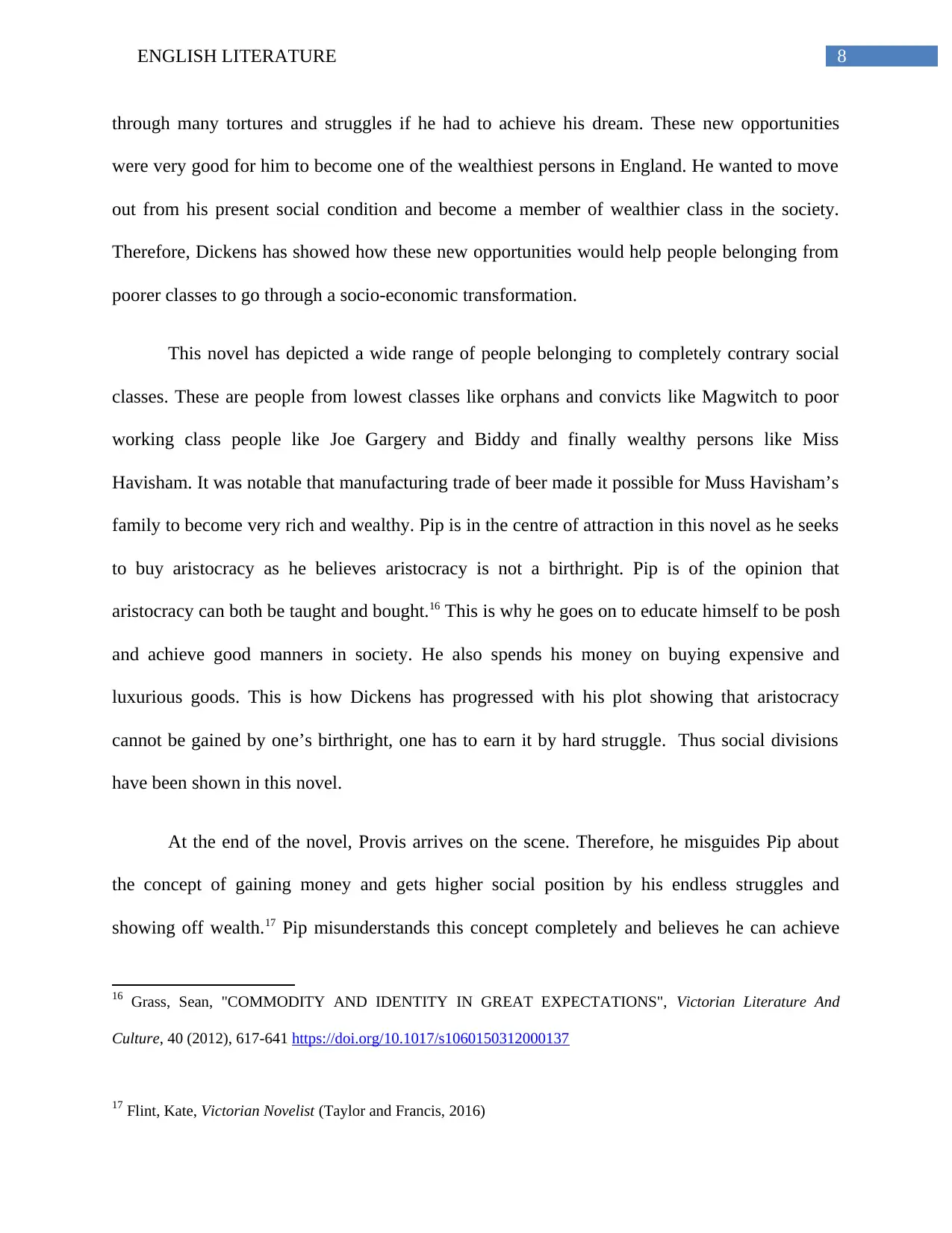
8ENGLISH LITERATURE
through many tortures and struggles if he had to achieve his dream. These new opportunities
were very good for him to become one of the wealthiest persons in England. He wanted to move
out from his present social condition and become a member of wealthier class in the society.
Therefore, Dickens has showed how these new opportunities would help people belonging from
poorer classes to go through a socio-economic transformation.
This novel has depicted a wide range of people belonging to completely contrary social
classes. These are people from lowest classes like orphans and convicts like Magwitch to poor
working class people like Joe Gargery and Biddy and finally wealthy persons like Miss
Havisham. It was notable that manufacturing trade of beer made it possible for Muss Havisham’s
family to become very rich and wealthy. Pip is in the centre of attraction in this novel as he seeks
to buy aristocracy as he believes aristocracy is not a birthright. Pip is of the opinion that
aristocracy can both be taught and bought.16 This is why he goes on to educate himself to be posh
and achieve good manners in society. He also spends his money on buying expensive and
luxurious goods. This is how Dickens has progressed with his plot showing that aristocracy
cannot be gained by one’s birthright, one has to earn it by hard struggle. Thus social divisions
have been shown in this novel.
At the end of the novel, Provis arrives on the scene. Therefore, he misguides Pip about
the concept of gaining money and gets higher social position by his endless struggles and
showing off wealth.17 Pip misunderstands this concept completely and believes he can achieve
16 Grass, Sean, "COMMODITY AND IDENTITY IN GREAT EXPECTATIONS", Victorian Literature And
Culture, 40 (2012), 617-641 https://doi.org/10.1017/s1060150312000137
17 Flint, Kate, Victorian Novelist (Taylor and Francis, 2016)
through many tortures and struggles if he had to achieve his dream. These new opportunities
were very good for him to become one of the wealthiest persons in England. He wanted to move
out from his present social condition and become a member of wealthier class in the society.
Therefore, Dickens has showed how these new opportunities would help people belonging from
poorer classes to go through a socio-economic transformation.
This novel has depicted a wide range of people belonging to completely contrary social
classes. These are people from lowest classes like orphans and convicts like Magwitch to poor
working class people like Joe Gargery and Biddy and finally wealthy persons like Miss
Havisham. It was notable that manufacturing trade of beer made it possible for Muss Havisham’s
family to become very rich and wealthy. Pip is in the centre of attraction in this novel as he seeks
to buy aristocracy as he believes aristocracy is not a birthright. Pip is of the opinion that
aristocracy can both be taught and bought.16 This is why he goes on to educate himself to be posh
and achieve good manners in society. He also spends his money on buying expensive and
luxurious goods. This is how Dickens has progressed with his plot showing that aristocracy
cannot be gained by one’s birthright, one has to earn it by hard struggle. Thus social divisions
have been shown in this novel.
At the end of the novel, Provis arrives on the scene. Therefore, he misguides Pip about
the concept of gaining money and gets higher social position by his endless struggles and
showing off wealth.17 Pip misunderstands this concept completely and believes he can achieve
16 Grass, Sean, "COMMODITY AND IDENTITY IN GREAT EXPECTATIONS", Victorian Literature And
Culture, 40 (2012), 617-641 https://doi.org/10.1017/s1060150312000137
17 Flint, Kate, Victorian Novelist (Taylor and Francis, 2016)
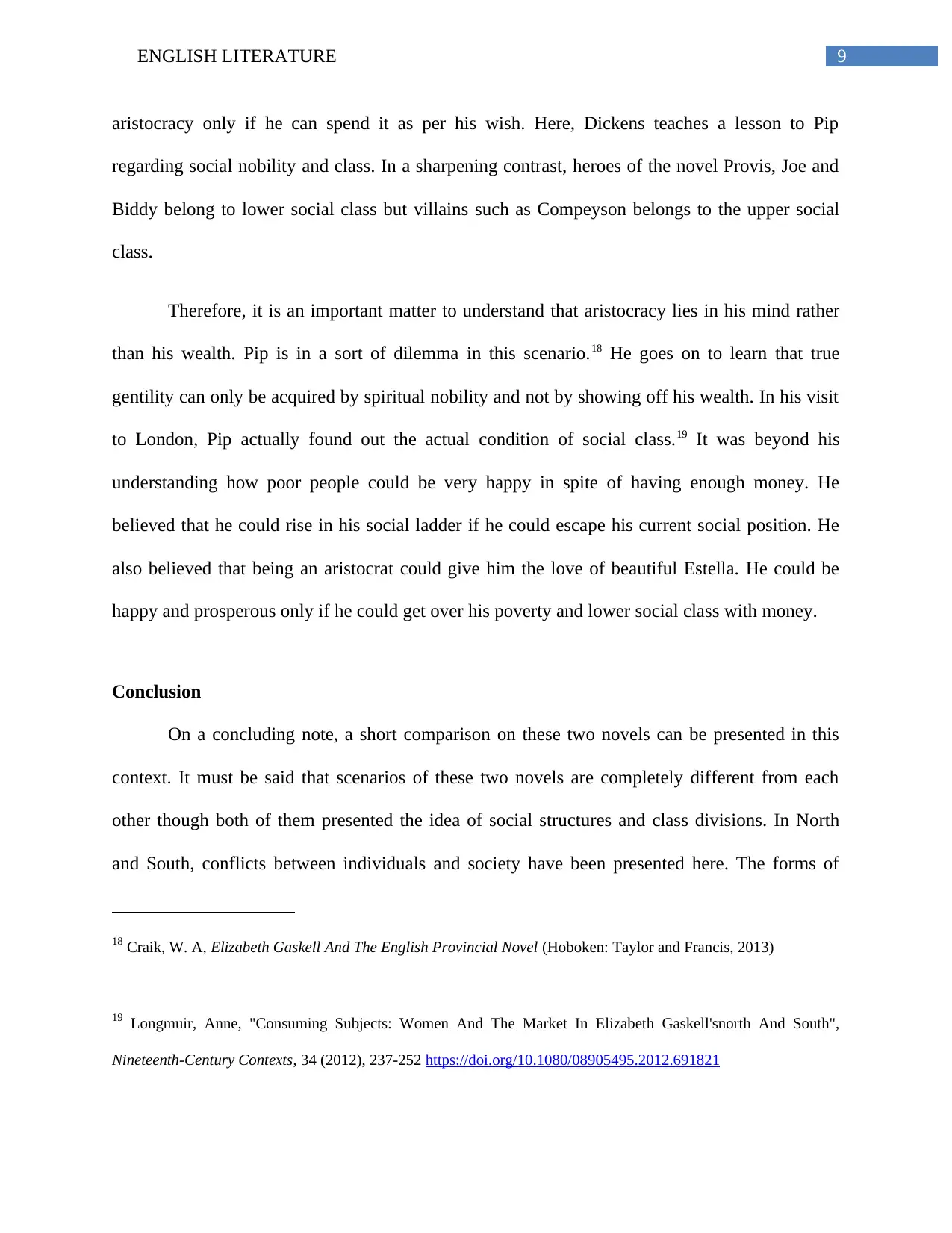
9ENGLISH LITERATURE
aristocracy only if he can spend it as per his wish. Here, Dickens teaches a lesson to Pip
regarding social nobility and class. In a sharpening contrast, heroes of the novel Provis, Joe and
Biddy belong to lower social class but villains such as Compeyson belongs to the upper social
class.
Therefore, it is an important matter to understand that aristocracy lies in his mind rather
than his wealth. Pip is in a sort of dilemma in this scenario.18 He goes on to learn that true
gentility can only be acquired by spiritual nobility and not by showing off his wealth. In his visit
to London, Pip actually found out the actual condition of social class.19 It was beyond his
understanding how poor people could be very happy in spite of having enough money. He
believed that he could rise in his social ladder if he could escape his current social position. He
also believed that being an aristocrat could give him the love of beautiful Estella. He could be
happy and prosperous only if he could get over his poverty and lower social class with money.
Conclusion
On a concluding note, a short comparison on these two novels can be presented in this
context. It must be said that scenarios of these two novels are completely different from each
other though both of them presented the idea of social structures and class divisions. In North
and South, conflicts between individuals and society have been presented here. The forms of
18 Craik, W. A, Elizabeth Gaskell And The English Provincial Novel (Hoboken: Taylor and Francis, 2013)
19 Longmuir, Anne, "Consuming Subjects: Women And The Market In Elizabeth Gaskell'snorth And South",
Nineteenth-Century Contexts, 34 (2012), 237-252 https://doi.org/10.1080/08905495.2012.691821
aristocracy only if he can spend it as per his wish. Here, Dickens teaches a lesson to Pip
regarding social nobility and class. In a sharpening contrast, heroes of the novel Provis, Joe and
Biddy belong to lower social class but villains such as Compeyson belongs to the upper social
class.
Therefore, it is an important matter to understand that aristocracy lies in his mind rather
than his wealth. Pip is in a sort of dilemma in this scenario.18 He goes on to learn that true
gentility can only be acquired by spiritual nobility and not by showing off his wealth. In his visit
to London, Pip actually found out the actual condition of social class.19 It was beyond his
understanding how poor people could be very happy in spite of having enough money. He
believed that he could rise in his social ladder if he could escape his current social position. He
also believed that being an aristocrat could give him the love of beautiful Estella. He could be
happy and prosperous only if he could get over his poverty and lower social class with money.
Conclusion
On a concluding note, a short comparison on these two novels can be presented in this
context. It must be said that scenarios of these two novels are completely different from each
other though both of them presented the idea of social structures and class divisions. In North
and South, conflicts between individuals and society have been presented here. The forms of
18 Craik, W. A, Elizabeth Gaskell And The English Provincial Novel (Hoboken: Taylor and Francis, 2013)
19 Longmuir, Anne, "Consuming Subjects: Women And The Market In Elizabeth Gaskell'snorth And South",
Nineteenth-Century Contexts, 34 (2012), 237-252 https://doi.org/10.1080/08905495.2012.691821
Secure Best Marks with AI Grader
Need help grading? Try our AI Grader for instant feedback on your assignments.
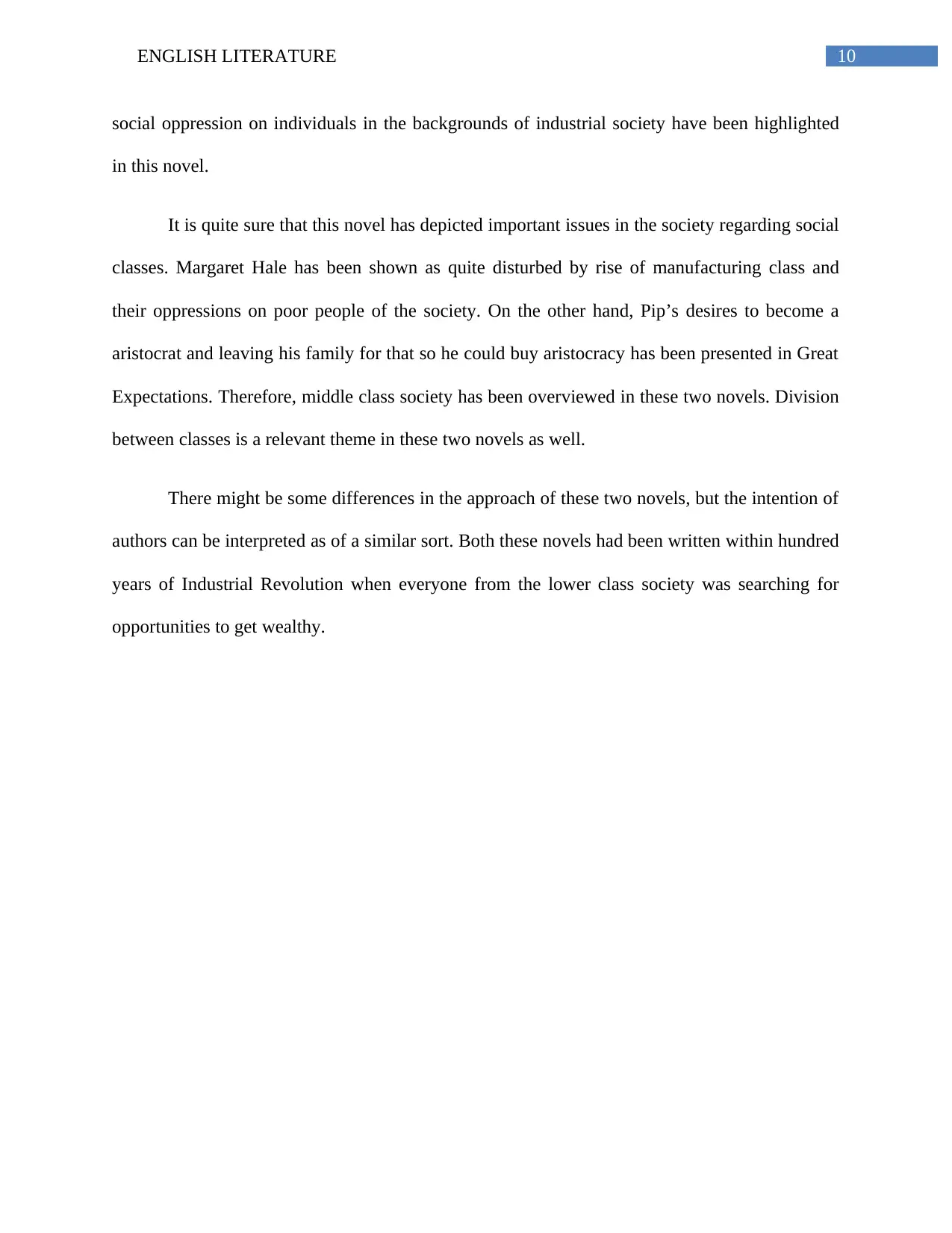
10ENGLISH LITERATURE
social oppression on individuals in the backgrounds of industrial society have been highlighted
in this novel.
It is quite sure that this novel has depicted important issues in the society regarding social
classes. Margaret Hale has been shown as quite disturbed by rise of manufacturing class and
their oppressions on poor people of the society. On the other hand, Pip’s desires to become a
aristocrat and leaving his family for that so he could buy aristocracy has been presented in Great
Expectations. Therefore, middle class society has been overviewed in these two novels. Division
between classes is a relevant theme in these two novels as well.
There might be some differences in the approach of these two novels, but the intention of
authors can be interpreted as of a similar sort. Both these novels had been written within hundred
years of Industrial Revolution when everyone from the lower class society was searching for
opportunities to get wealthy.
social oppression on individuals in the backgrounds of industrial society have been highlighted
in this novel.
It is quite sure that this novel has depicted important issues in the society regarding social
classes. Margaret Hale has been shown as quite disturbed by rise of manufacturing class and
their oppressions on poor people of the society. On the other hand, Pip’s desires to become a
aristocrat and leaving his family for that so he could buy aristocracy has been presented in Great
Expectations. Therefore, middle class society has been overviewed in these two novels. Division
between classes is a relevant theme in these two novels as well.
There might be some differences in the approach of these two novels, but the intention of
authors can be interpreted as of a similar sort. Both these novels had been written within hundred
years of Industrial Revolution when everyone from the lower class society was searching for
opportunities to get wealthy.
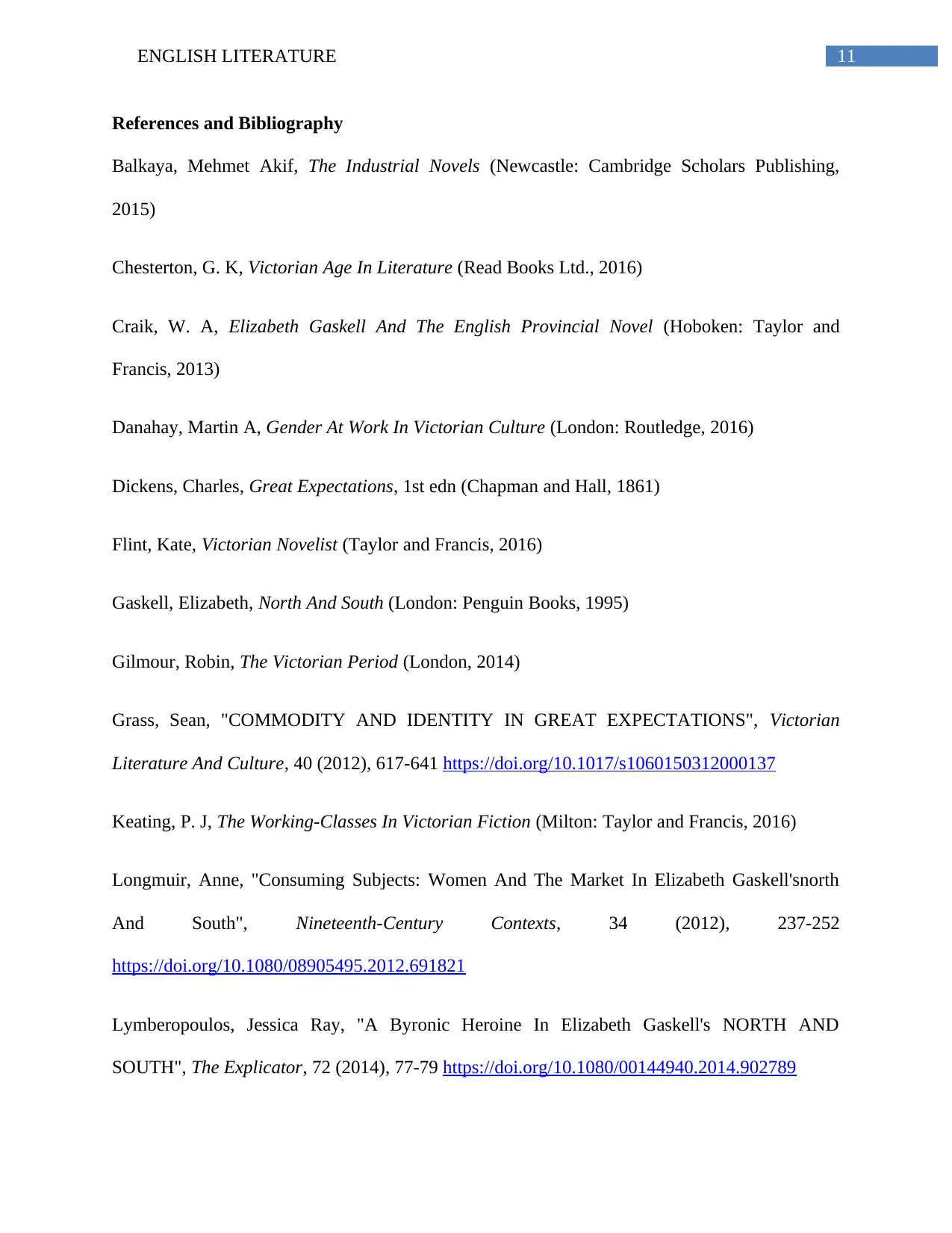
11ENGLISH LITERATURE
References and Bibliography
Balkaya, Mehmet Akif, The Industrial Novels (Newcastle: Cambridge Scholars Publishing,
2015)
Chesterton, G. K, Victorian Age In Literature (Read Books Ltd., 2016)
Craik, W. A, Elizabeth Gaskell And The English Provincial Novel (Hoboken: Taylor and
Francis, 2013)
Danahay, Martin A, Gender At Work In Victorian Culture (London: Routledge, 2016)
Dickens, Charles, Great Expectations, 1st edn (Chapman and Hall, 1861)
Flint, Kate, Victorian Novelist (Taylor and Francis, 2016)
Gaskell, Elizabeth, North And South (London: Penguin Books, 1995)
Gilmour, Robin, The Victorian Period (London, 2014)
Grass, Sean, "COMMODITY AND IDENTITY IN GREAT EXPECTATIONS", Victorian
Literature And Culture, 40 (2012), 617-641 https://doi.org/10.1017/s1060150312000137
Keating, P. J, The Working-Classes In Victorian Fiction (Milton: Taylor and Francis, 2016)
Longmuir, Anne, "Consuming Subjects: Women And The Market In Elizabeth Gaskell'snorth
And South", Nineteenth-Century Contexts, 34 (2012), 237-252
https://doi.org/10.1080/08905495.2012.691821
Lymberopoulos, Jessica Ray, "A Byronic Heroine In Elizabeth Gaskell's NORTH AND
SOUTH", The Explicator, 72 (2014), 77-79 https://doi.org/10.1080/00144940.2014.902789
References and Bibliography
Balkaya, Mehmet Akif, The Industrial Novels (Newcastle: Cambridge Scholars Publishing,
2015)
Chesterton, G. K, Victorian Age In Literature (Read Books Ltd., 2016)
Craik, W. A, Elizabeth Gaskell And The English Provincial Novel (Hoboken: Taylor and
Francis, 2013)
Danahay, Martin A, Gender At Work In Victorian Culture (London: Routledge, 2016)
Dickens, Charles, Great Expectations, 1st edn (Chapman and Hall, 1861)
Flint, Kate, Victorian Novelist (Taylor and Francis, 2016)
Gaskell, Elizabeth, North And South (London: Penguin Books, 1995)
Gilmour, Robin, The Victorian Period (London, 2014)
Grass, Sean, "COMMODITY AND IDENTITY IN GREAT EXPECTATIONS", Victorian
Literature And Culture, 40 (2012), 617-641 https://doi.org/10.1017/s1060150312000137
Keating, P. J, The Working-Classes In Victorian Fiction (Milton: Taylor and Francis, 2016)
Longmuir, Anne, "Consuming Subjects: Women And The Market In Elizabeth Gaskell'snorth
And South", Nineteenth-Century Contexts, 34 (2012), 237-252
https://doi.org/10.1080/08905495.2012.691821
Lymberopoulos, Jessica Ray, "A Byronic Heroine In Elizabeth Gaskell's NORTH AND
SOUTH", The Explicator, 72 (2014), 77-79 https://doi.org/10.1080/00144940.2014.902789
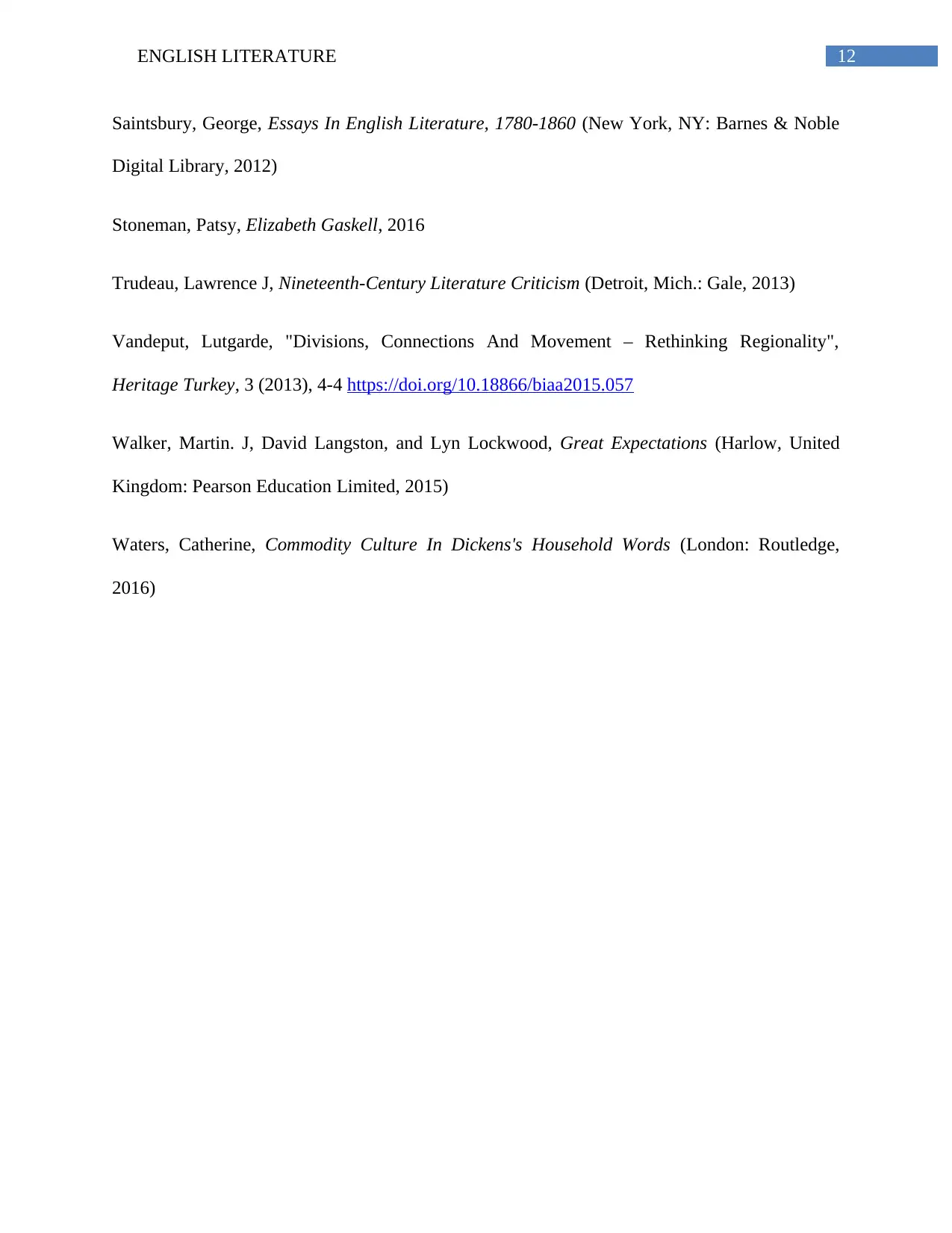
12ENGLISH LITERATURE
Saintsbury, George, Essays In English Literature, 1780-1860 (New York, NY: Barnes & Noble
Digital Library, 2012)
Stoneman, Patsy, Elizabeth Gaskell, 2016
Trudeau, Lawrence J, Nineteenth-Century Literature Criticism (Detroit, Mich.: Gale, 2013)
Vandeput, Lutgarde, "Divisions, Connections And Movement – Rethinking Regionality",
Heritage Turkey, 3 (2013), 4-4 https://doi.org/10.18866/biaa2015.057
Walker, Martin. J, David Langston, and Lyn Lockwood, Great Expectations (Harlow, United
Kingdom: Pearson Education Limited, 2015)
Waters, Catherine, Commodity Culture In Dickens's Household Words (London: Routledge,
2016)
Saintsbury, George, Essays In English Literature, 1780-1860 (New York, NY: Barnes & Noble
Digital Library, 2012)
Stoneman, Patsy, Elizabeth Gaskell, 2016
Trudeau, Lawrence J, Nineteenth-Century Literature Criticism (Detroit, Mich.: Gale, 2013)
Vandeput, Lutgarde, "Divisions, Connections And Movement – Rethinking Regionality",
Heritage Turkey, 3 (2013), 4-4 https://doi.org/10.18866/biaa2015.057
Walker, Martin. J, David Langston, and Lyn Lockwood, Great Expectations (Harlow, United
Kingdom: Pearson Education Limited, 2015)
Waters, Catherine, Commodity Culture In Dickens's Household Words (London: Routledge,
2016)
1 out of 13
Related Documents
Your All-in-One AI-Powered Toolkit for Academic Success.
+13062052269
info@desklib.com
Available 24*7 on WhatsApp / Email
![[object Object]](/_next/static/media/star-bottom.7253800d.svg)
Unlock your academic potential
© 2024 | Zucol Services PVT LTD | All rights reserved.





